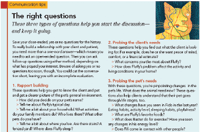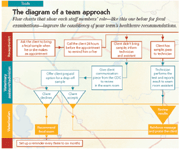Map the path to better care
When you, your team, and your clients are reading from the same set of directions, you make it to your end goal-better pet care-with fewer detours.
Have you ever enjoyed the pleasure of riding in a car with an on-board navigation system? Imagine you're traveling solo to a strange city and you're picking up a rental car. You desperately wish you could teleport to your hotel, but here you are, facing the drive alone at night. You sigh as you turn the key. Just then you spot a small computer screen in the dash. And in minutes, after you enter your destination address, a calm voice gently guides you to your hotel.

Illustration by Phil Bliss
This voice tells you when to turn, as the map shows you labeled streets and landmarks. It even predicts the time of your arrival. If, by chance, you make an incorrect turn, the system recalculates and figures out the steps to get you back on track.
Just as you trust the navigation system to make recommendations that keep you on track and safe, your clients trust you to guide them to healthy choices for their pets. The clients' and pets' needs are your end destination. And you and your team develop the directions and the maps to show clients the way. These recommendations, grounded in pets' needs for maximum health and quality of life, are the lifeblood of any hospital.
Use your expertise to blaze a trail
As the software of the hospital's navigation system, you, the doctor, determine the standards of care that team members follow as they lead the client's pet to health. You can accomplish this by creating maps for your team so everyone—receptionists, technicians, kennel personnel, and veterinarians—knows how a visit will progress and what a pet could need depending on its lifestyle, life stage, and genetic risk. (See "The Diagram of a Team Approach" for a sample chart.)
Establishing set standards ensures that everyone's on the same page. So whether you're treating a puppy, adult, or senior pet, every team member's taking into account the same things, sending the same messages to the client, and reinforcing those messages. You're providing the best care for the patient because you're building in fail-safe mechanisms. You know you'll talk about topics such as genetic risk, nutritional needs, and exercise. And you're protecting your patients and their owners, because you're touching on lifestyle situations that put people at risk, such as pets sleeping with children.

The right questions
This could seem like a lot for your team members to remember. But your team has a map to follow. When you train your staff members to promote the care you recommend, they understand the importance of all wellness procedures—including vaccinations, exams, ovariohysterectomies, neuters, senior care, dental care, and so on. And they're prepared to talk to—and educate—clients about these issues.
Your next step: Institute healthcare plans in your practice. Otherwise known as estimates, these plans also help ensure that you're recommending all the care your standards require.
Without established standards of care and healthcare plans, you risk each team member pulling out his or her map of whichever city they happen to be carrying around and making recommendations that could confuse the client. When you develop these tools for your team, you've marked the path to healthier pets and given team members the directions.
Point the way for clients
All you really need to reach clients is the ability to ask questions and listen to their answers. Clients' answers help you fill in the final address in your navigation system; the pet's and client's needs mark the end point.
Asking the right questions—and really listening to the answers—is often one of the toughest challenges practicing veterinarians face. After all, veterinary school taught each and every one of us how to ask questions that elicit specific information: Did your pet eat this morning? Did your pet go to the bathroom this morning? Did your pet vomit this morning?
What we weren't taught is the art of unlocking a client's mind. What can you learn from the client that will give you the opportunity to serve him or her better? The answer comes when you ask the right kind of questions—open-ended questions.

The diagram of a team approach
I was in a hospital once when the doctor asked this close-ended question: "Do you give your pet table scraps?" The answer: "No." Just imagine what kind of information we might have received if the doctor had asked an open-ended question: "What's your pet's favorite food?" The answer to this question might yield new insight into the pet's eating habits.
Close-ended questions are good for soliciting yes or no answers, and they're appropriate when you're gathering the patient's history. But open-ended questions provide the how, what, and when information. The answers to these questions help the client look deeper into the reasons for the pet's behavior and understand its needs.
To make good recommendations you must see the disease process from the client's perspective and you must help the client see the disease process from yours. This is the diagnostic gap. If you diagnose dental disease and recommend a dental cleaning—but the client didn't understand he or she should have been giving dental care to Fluffy—then the gap is so large that the client can't see why it's important to take your recommendation.
You can fill the gap by asking questions that begin with how, when, or what. For example, "How are you caring for Muffin's teeth?" Then demonstrate what's been happening to the pet's teeth, talk with the client about the disease process and what damage it can do to Muffin's long-term health, and then make the recommendation to clean Muffin's teeth and give her a healthy new start.
Instead, we too often jump into the pathogenesis of the disease and make our recommendation using that language. We recommend a dental prophy, and the client says they're not interested in that service today. We jump to the notion that the client doesn't like the idea of the anesthesia, or that the cost is stopping him or her.
It's more likely that the client doesn't know how to respond. And she might not understand that the pet is uncomfortable or that the procedure could extend the length and improve the quality of the pet's life.
Clients comply with a recommendation because they trust the hospital (the navigation system) and they want to take care of their pet (the end destination). So the key to compliance is to pinpoint clients' needs—just like you must provide the navigation system with a complete address—or you'll recommend something they don't feel any connection to. You took them where they didn't want to go. In fact, the health issue you feel is the most critical may not even be the reason a client came to see you. In this case, you may need to address the client's concerns first, then move on to the new problem.
Get your team in gear
Every member of your healthcare team is important in delivering a consistent message. Let's say your team recommends that every pet undergo an intestinal parasite check.
When your receptionist calls to remind clients about appointments, she also reminds them to bring in a walnut-sized fecal sample. When the client comes in, the receptionist gives her a handout or maybe the CDC pamphlet on zoonotic disease to review while the client's waiting. The receptionist has started the education process by making the client aware that even indoor pets can have intestinal parasites.
The technician takes the client and pet to the exam room and asks a series of questions such as, "How do you exercise your pet?"; "When is your pet around other animals?"; and "Where does your pet sleep?" The technician explains that some activities put the pet at risk for intestinal parasites and heartworms—and may put the family at risk as well. The technician can review the handouts and answer clients' questions about how to apply the information to their pet and circumstances.
When the veterinarian comes in, he or she reviews all the information the technician collected and then recommends an intestinal parasite check. The chance the client will say "yes" is much greater because at this point she's heard the message from three different people and sees the value of the procedure. When the client leaves, the receptionist congratulations her on the "no parasite seen" fecal test, or gives her medicine and commends her for the steps she's taking to keep the pet and family healthy.
It isn't difficult to navigate recommendations if your whole team knows the path you intend to take to keep each pet healthy. The trust the client develops in the team, and the determination of the pet's lifestyle, life stage, and genetic predispositions, create recommendations that bond clients to your hospital for life. No wrong turns or detours here. Just clear, consistent veterinary experiences.
The bottom line
Follow this route to clear, consistent, and stronger recommendations:
- Develop standards of care.
- Create flow charts showing each person's role in common procedures.
- Use healthcare plans, or estimates, to ensure you're recommending everything that's part of your standard.
- Train team members to understand and communicate pets' basic wellness needs.
- Build in open-ended questions so you understand each client's and pet's needs better.

Mary Ann Vande Linde, DVM
Dr. Mary Ann Vande Linde is a consultant with Vande Linde and Associates in Atlanta. Please send questions or comments to ve@advanstar.com.